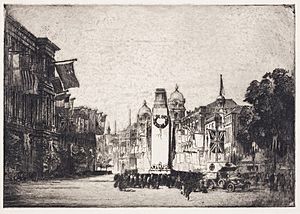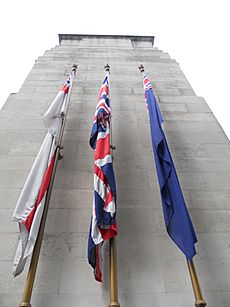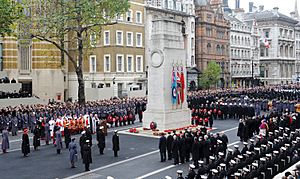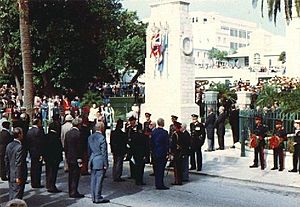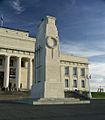The Cenotaph facts for kids
Quick facts for kids The Cenotaph |
|
|---|---|
| United Kingdom | |
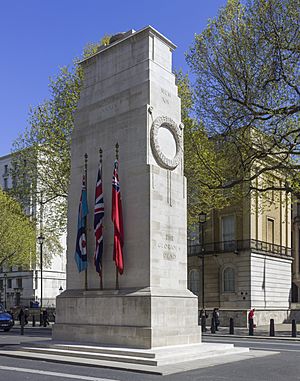 |
|
| For the British Empire (later Commonwealth) dead of both World Wars and the British military in later wars | |
| Unveiled | 11 November 1920 |
| Location | 51°30′09.6″N 0°07′34.1″W / 51.502667°N 0.126139°W |
| Designed by | Edwin Lutyens |
|
THE GLORIOUS DEAD
|
|
|
Listed Building – Grade I
|
|
| Official name | The Cenotaph |
| Designated | 5 February 1970 |
| Reference no. | 1357354 |
The Cenotaph is a special war memorial located on Whitehall in London, England. It started as a temporary structure built for a peace parade after World War I. People felt so strongly about it that a permanent stone memorial was built in 1920. It became the United Kingdom's official national war memorial.
Edwin Lutyens designed the permanent Cenotaph. It was built from Portland stone between 1919 and 1920. Each year, a Service of Remembrance is held here on Remembrance Sunday. This day is the closest Sunday to November 11th, which is Armistice Day. Lutyens's design for the Cenotaph has been copied in many places. You can find similar memorials in countries like Australia, Canada, New Zealand, and Hong Kong.
Contents
Why the Cenotaph Was Built
The World War I (1914–1918) caused a huge number of deaths. Over 1.1 million soldiers from the British Empire lost their lives. After the war, many memorials were built across Britain and its empire. These memorials honored those who had died.
Sir Edwin Lutyens was a very famous architect at that time. He designed many war memorials. He was known for designing grand country houses and even parts of New Delhi, the capital of British India. The war deeply affected Lutyens. He spent a lot of his time helping to remember the fallen soldiers. He also advised the Commonwealth War Graves Commission.
Lutyens had designed other memorials before the Cenotaph. The word cenotaph comes from a Greek term meaning "empty tomb." Ancient Greeks built cenotaphs when a body could not be found for burial. During World War I, British soldiers were buried where they fell. Their bodies were not brought home. So, the Cenotaph became a symbol for these absent dead. It was like a tomb for everyone who couldn't have a proper burial at home.
The First Temporary Cenotaph
World War I officially ended on June 28, 1919. The British government planned a big victory parade in London for July 19. Soldiers would march down Whitehall. The first Cenotaph was one of several temporary structures built for this parade.
The Prime Minister, David Lloyd George, wanted a special spot for the marching troops to salute. He asked Lutyens to design a "catafalque" (a raised platform for a coffin). Lloyd George wanted it to be for everyone, no matter their religion. Lutyens quickly sketched his idea, which looked very much like the Cenotaph we see today.
Lutyens had thought about this design for a while. He had worked on similar ideas for other memorials. He sent his final design to the government in early July. It was approved on July 7. The temporary Cenotaph was unveiled quietly on July 18, 1919. Lutyens was not even invited to this event.
During the parade, 15,000 soldiers and 1,500 officers marched past. They saluted the Cenotaph. Famous generals from America, France, and Britain were there. The Cenotaph quickly became very important to the public. Since bodies were not brought home, it became a symbol for all the soldiers who died. People started placing flowers and wreaths around its base. Within a week, about 1.2 million people visited the Cenotaph to show their respect.
Building the Permanent Cenotaph
Soon after the parade, people wanted the temporary Cenotaph to be rebuilt in stone. Members of the public and newspapers asked for a permanent structure. A Member of Parliament, William Ormsby-Gore, asked the government about it. The Prime Minister's team agreed to rebuild it in stone. They decided to keep it in the same spot on Whitehall.
Construction of the permanent Cenotaph began in May 1920. Lutyens had a chance to make small changes to his design. He replaced the real laurel wreaths with stone sculptures. He also added a subtle curve to the monument's lines. This special curve, called entasis, makes the structure look more natural and alive. It's similar to how ancient Greek temples like the Parthenon were built.
Lutyens also wanted to use carved stone flags instead of cloth ones. He worried the fabric flags would wear out quickly. However, the government decided to keep cloth flags. Lutyens was unhappy about this, but he later used stone flags in other memorials he designed.
What the Cenotaph Looks Like
The Cenotaph is made entirely from Portland stone. It looks like a tall, rectangular pillar. It has several levels that get smaller as they go up. At the very top is a sculpted tomb chest, which is an "empty tomb." On this tomb chest, there is a stone laurel wreath.
The monument is very simple. It has little decoration. On each end, below the tomb, there is a laurel wreath. These were carved by sculptor Francis Derwent Wood. On the sides, the words "THE GLORIOUS DEAD" are carved. The dates of the World Wars are also carved in Roman numerals. World War I dates are on the ends, and World War II dates are on the sides.
None of the lines on the Cenotaph are perfectly straight. They have a very slight curve, which is hard to see. This special design makes the monument feel more grand and draws your eye upwards.
The Cenotaph has flags on each side. These are the Union Flag, the White Ensign, and the Blue Ensign. Later, an RAF Ensign (Royal Air Force flag) was added.
Unveiling the Memorial
The Cenotaph cost about £7,325 to build. Construction started on January 19, 1920. The government wanted it ready for Remembrance Day (November 11). In September 1920, it was announced that King George V would unveil it on November 11. This was the second anniversary of the Armistice.
A special funeral was also planned for an unidentified soldier. This soldier, known as the Unknown Warrior, was brought from France to be buried in Westminster Abbey. The unveiling of the Cenotaph became part of this funeral procession.
King George V unveiled the Cenotaph at 11:00 AM on November 11. Lutyens, the designer, was there this time. The King laid a wreath on the Unknown Warrior's gun-carriage. Then, he unveiled the Cenotaph, which was covered in large Union Flags. A short version of Sir Edward Elgar's music for Lawrence Binyon's poem 'For the Fallen' was sung.
The public's reaction was even stronger than for the temporary Cenotaph. Whitehall was closed for days. People came to walk past the Cenotaph and lay flowers. Within a week, the flowers were 10 feet deep. About 1.25 million people had visited the memorial.
Later Years and Importance
In the 1920s and 1930s, it was common for men to take off their hats when passing the Cenotaph. There were ideas to add statues or a light beam to the Cenotaph. But these ideas were rejected because they would change its simple, powerful design.
Parts of the original temporary Cenotaph were kept by the Imperial War Museum. However, it was later destroyed by a bomb during World War II.
The Cenotaph was first built to remember those who died in World War I. But after World War II, its meaning was expanded. The dates of World War II (1939-1945) were added to its sides. King George VI unveiled it again on November 10, 1946. Today, the Cenotaph also remembers those who died in other wars where British service members have fought. In 1970, the Cenotaph was given a special Grade I listed building status. This means it is a very important historical building.
Sometimes, during protests, the Cenotaph has been damaged. In 2020, it was covered up for a while to protect it. Despite these incidents, the Cenotaph remains a very important place for remembrance.
Remembrance Services at the Cenotaph
The Cenotaph is the main site for the annual National Service of Remembrance. This service happens at 11:00 AM on Remembrance Sunday. This is the Sunday closest to November 11th, Armistice Day. From 1919 to 1945, the service was on Armistice Day itself. But since 1945, it has been on Remembrance Sunday. Soldiers and other uniformed personnel salute the Cenotaph as they pass by.
The first modern ceremony was held on November 11, 1919. King George V suggested a two-minute silence across the UK. Thousands gathered around the temporary Cenotaph. The Prime Minister and a representative from France laid wreaths. Veterans' groups also marched past.
Other remembrance services also take place at the Cenotaph throughout the year. For example, the Royal Tank Regiment holds a parade there. This is near Cambrai Day (November 20), which remembers a big tank battle. On ANZAC Day (April 25), a special ceremony is held. This day honors soldiers from Australia and New Zealand.
The Combined Irish Regiments Association also holds an annual parade. This remembers Irish soldiers who died in World War I. The Belgian Parade has taken place yearly since 1934. Belgium is the only foreign country allowed to parade its uniformed troops in central London.
The Cenotaph's Influence
Art and Literature Inspired by the Cenotaph
The Cenotaph has appeared in many artworks. These include paintings like Immortal Shrine (1928) by Will Longstaff. Another famous painting is The Cenotaph (Morning of the Peace Procession) (1919) by Sir William Nicholson. The Cenotaph was also on a special medal in 1928.
-
The temporary cenotaph on the morning of the Peace Procession in 1919 by Sir William Nicholson
Many poems have also been written about the Cenotaph. These include 'The Cenotaph' (1919) by Charlotte Mew and 'At the Cenotaph' (1933) by Siegfried Sassoon.
How the Cenotaph Influenced Other Memorials
The Cenotaph in London became a very important design for other war memorials. Many towns and cities built memorials that looked similar to Lutyens's design. Even though the word "cenotaph" means "empty tomb," it started to be used for almost any war memorial that wasn't a real tomb.
Lutyens designed other cenotaphs himself. The Southampton Cenotaph was unveiled just before the permanent London one. Many other places, especially in the British Empire, built memorials based on the London Cenotaph. It was one of the most influential war memorials ever.
Smaller versions of the Cenotaph were built for specific army regiments. These include the Queen's Own Royal West Kent Regiment Cenotaph and the Royal Berkshire Regiment War Memorial. Other similar memorials include the Midland Railway War Memorial in Derby and the Rochdale Cenotaph.
Exact copies or very similar versions of the London Cenotaph can be found around the world. These include the Hong Kong Cenotaph (1923), the Manchester Cenotaph (1924), and the Toronto Cenotaph (1925). A two-thirds size copy is in Hamilton, Bermuda. There are also copies in Auckland, New Zealand, and London, Ontario, Canada.
-
Hong Kong Cenotaph, Hong Kong
-
Auckland Cenotaph, New Zealand
-
London Cenotaph in London, Ontario, Canada
-
Montreal Cenotaph, Canada
-
Midland Railway War Memorial, Derby
-
Welch Regiment War Memorial at Maindy Barracks, Cardiff
See also
 In Spanish: Cenotafio (Londres) para niños
In Spanish: Cenotafio (Londres) para niños



